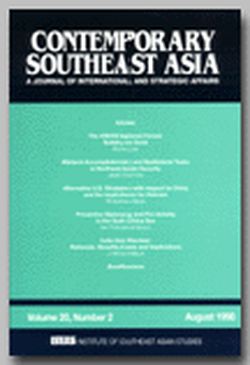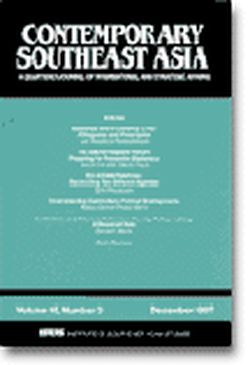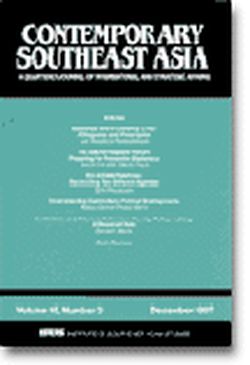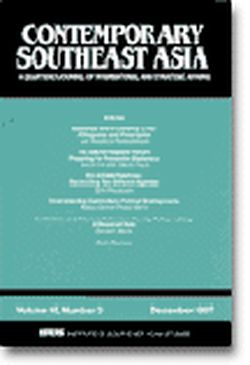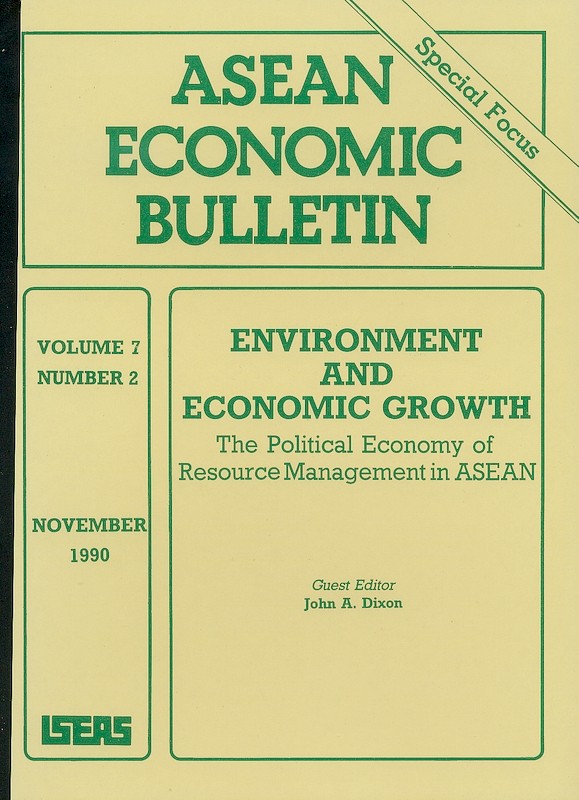Contemporary Southeast Asia: A Journal of International and Strategic Affairs Vol. 16/3 (Dec 1994)

Date of publication:
December 1994
Number of pages:
110
Code:
CS16/3
Contents
-
Preliminary pages
- ARTICLES
-
From ASEAN Six to ASEAN Ten: Issues and Prospects, by M R Sukhumbhand Paribatra, author see abstractFrom the Bangkok Declaration of 1967, successive generations of ASEAN leaderships have envisaged the organization to be a regional, rather than a sub-regional, one. But in the past, opportunities to build a truly region-wide order had always been constrained by exigencies of the Cold War and the various regional conflicts. With the end of the Cold War, prospects for deepening and expanding ASEAN co-operation have emerged. Nevertheless, there are a number of problems and issues, both actual and potential, which act or may act as constraints of varying severity upon the process of expanding ASEAN membership from six to ten, allowing Vietnam, Laos, Cambodia and Myanmar to Join the organization and making it a truly regional one. Here, it is argued that, while these problems and issues should not be underestimated, they are not, and should not be considered, reasons for ASEAN to abandon its "doctrinal" commitment to transfer itself into a region-wide body. The existence of these constraints merely raises questions concerning the timing, conditions and modalities of expansion, which will accomplish ASEAN's "historic mission" of making Southeast Asia one.
-
Vietnam's Membership in ASEAN: Economic, Political and Security Implications, by Hoang Anh Tuan, author see abstractSoutheast Asia faces tremendous challenges in the last years of the twentieth century. A shift in the balance of forces among the maJor powers along with the revival of past suspicions and rivalries and the emergence of new ambitions by states constitute potential threats to the region's peace and stability. Economic issues are no less challenging. One of the region's responses has been to contemplate expanding ASEAN's membership to incorporate other countries in Southeast Asia, especially Vietnam. Recent improvements in Vietnam-ASEAN relations give cause to believe that Vietnam will soon become a member of the Association. Starting from the premise of Vietnam as a member of ASEAN, this article seeks to explore the economic, political, and security implications for Vietnam and other ASEAN countries as well as their relations with outside powers in the context of a changing regional and international environment.
-
China's Aspirations in the Spratly Islands, by Esmond D Smith Jr, author see abstractThe territorial dispute over the Spratly Island archipelago threatens to disrupt an era of unprecedented peace in Southeast Asia. Strategic position, on the one hand, and development rights to the offshore resources of much of the South China Sea, on the other, are the real staves in this dispute. And China appears to be headed for open conflict with Vietnam over offshore development rights in nearby waters. Technology, in the form of offshore oil drilling techniques, advanced military hardware and recently codified concepts of ocean law, offer China new capabilities in this dispute. Chinas use of military force to consolidate its position in the Spratlys would have serious implications for both the United States and ASEAN.
-
Unifying Korea: Beyond Hopes and Fears, by Leif Rosenberger, author see abstractFears of a North Korean invasion of South Korea are giving way to fears of a North Korean economic and political collapse. The post-Kim II Sung power struggle, the nuclear conflict, and North Korea's rapid economic decline all add fuel to the fire. If North Korea collapsed today, it would devastate the South Korean economy. To avert this adverse scenario, Seoul and Pyongyang must push ahead with their respective economic reforms, learn from German unity mistakes, develop peaceful Korean unification plans, and begin to put these plans into action.
-
"Thai-Style" Contractual Relationships: Two Case Studies, by Patcharee Siroros, Kenneth J Haller, authors see abstractThe rapid growth of the Thai economy and the concommitant need for infrastructural development has led to an increased role for private business in infrastructural projects. Perhaps the most interesting of the several forms of privatization of state enterprise activities in Thailand is the government-business contractual relationship and the BTO (build-transfer-operate) style infrastructural development it has spawned. State enterprises have ha difficulty adjusting their relationship to business from the traditional total-control hierarchical bureaucratic polity-style of the past to a more appropriate co-operative partnership style. Complications have arisen as a result of the contracting process itself, which is ill-defined, fraught with political manipulations, and encourages ambiguities in the contract.
-
U.S. Grand Strategy in Post-Cold War Asia-Pacific, by Renato Cruz De Castro, author see abstractAccess to the large Asian market and the prevention of any preponderant regional power have been the fundamental objectives of American policy for more than a century. This article discusses two important pillars of American hegemony in the Asia-Pacific: bilateral security arrangements, and forward deployment of sufficient military power. It notes that it is no longer in the interest of the United States to maintain the same hegemonic arrangement it had with regional countries. The absence of any tangible threat and increasing U.S. budgetary problems have created pressures for Washington to change its regional posture to one of linking regional economies to the economic security of the United States.


